ADVANCED HEART PROCEDURES
Cardiology Associates is dedicated to comprehensive cardiovascular care, emphasizing prevention, diagnosis, and treatment of heart and vascular conditions. With a team of board-certified cardiologists and advanced providers, Cardiology Associates offers an extensive range of services—from noninvasive imaging like echocardiography, CT angiography, and ultrasounds to advanced stress testing and cardiac monitoring. Our interventional cardiology capabilities include catheterization procedures, stenting, peripheral vascular interventions, and cutting-edge electrophysiology treatments such as ablations, pacemaker and defibrillator implants, and Watchman procedures. Cardiology Associates brings accredited expertise and patient-focused care to our community.
HEART CATHETERIZATION
AND INTERVENTION
Cardiac Catheterization is a procedure used to diagnose and treat cardiovascular conditions. It is performed as an outpatient procedure in the hospital. During cardiac catheterization, a long thin tube called a catheter is inserted in an artery or vein in the groin, neck or arm (transradial) and threaded through your blood vessels to the heart to determine if there is disease of the heart muscle, valves or coronary (heart) arteries. During the procedure, the pressure and blood flow in the heart can be measured.
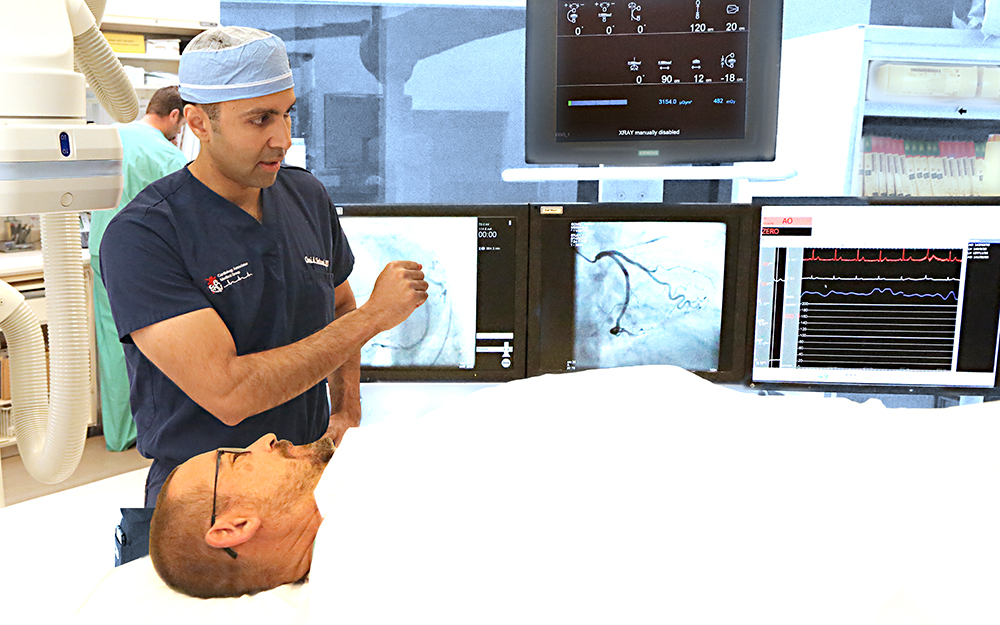

PERCUTANEOUS CORONARY INTERVENTION (PCI)
During a cardiac catheterization if it is determined that there are blockages that would benefit from a coronary stent, then a small tube-shaped device (stent) will be placed via the already in-place catheter, to keep the blocked coronary arteries open and increasing blood flow to the heart.
Dr. Shaun Patel, Dr. Omid Fatemi and Dr. Sogomonian are Interventional Cardiologists at Cardiology Associates.
CTO PERCUTANEOUS CORONARY INTERVENTION
CTO percutaneous coronary intervention is a minimally invasive technique used to treat patients with chronic total occlusion (CTO), or complete blockages, of the coronary arteries.
Dr. Omid Fatemi specializes in this procedure.
STRUCTURAL HEART PROCEDURES
Dr. Fatemi performs more advanced procedures within our structural heart program. Dr. Fatemi is the Director for the Structural Heart Department at Community Memorial Hospital and St. John’s Regional Medical Center.
ADVANCED PROCEDURES
TAVR
ADVANCED PROCEDURES
AORTIC VALVULOPLASTY
Aortic Valvuloplasty also known as balloon aortic valvotomy is the widening of a stenotic aortic valve using a balloon catheter inside the valve. The balloon is placed into the aortic valve that has become stiff from calcium buildup.
ADVANCED PROCEDURES
PFO CLOSURE
Percutaneous closure is a surgical procedure used to treat patients with patent foramen ovale (PFO) and atrial septal defect (ASD). Advancements in device technology and image guidance now permit the safe and effective catheter-based closure of numerous intracardiac defects, including PFO and ASD.
Dr. Omid Fatemi performs PFO Closures at Community Memorial Hospital.
ADVANCED PROCEDURES
ASD CLOSURE
ASD CLOSURE – Atrial Septal Defect (ASD) is an opening or hole in the wall that separates the two upper chambers of the heart. This wall is called the atrial septum. The hole causes oxygen-rich blood to leak from the left side of the heart to the right side. Different types of closure devices are used to close a hole or an opening between the right and left sides of the heart. Some of these birth defects are located in the wall (septum) between the upper chambers (atria) of the heart: Patent Foramen Ovale (PFO) Atrial Septal Defect (ASD).
Dr. Omid Fatemi performs these ASD Closures at Community Memorial Hospital.
ADVANCED PROCEDURES
MITRAL CLIP
ADVANCED PROCEDURES
TMVR
ADVANCED PROCEDURES
ARYTHMIA CENTER
CLINICAL ELECTROPHYSIOLOGY

Dr. Jonathan Dukes
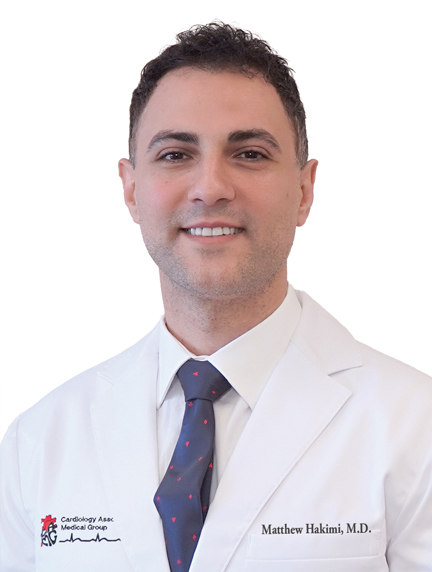
Dr. Matthew Hakimi
Dr. Jonathan Dukes, and Dr. Matthew Hakimi, Cardiac Electrophysiology Physicians, provide the most advanced evaluations, treatments and procedures for atrial fibrillation (AFib) and other circuitry issues to Ventura County residents. Dr. Dukes is the Director of Electrophysiology at Community Memorial Hospital.
CATHETER ABLATION
ADVANCED PROCEDURES
WATCHMAN
The Watchman Procedure is among the newest procedures available to prevent
A-fib related stroke.
Dr. Jonathan Dukes and
Dr Fatemi perform the Watchman Procedure.
ADVANCED PROCEDURES
PACEMAKER IMPLANTATION
A pacemaker insertion is the implantation of a small electronic device that is usually placed in the chest (just below the collarbone) to help regulate slow electrical problems of the heart. A pacemaker may be recommended to ensure that the heartbeat does not slow to a dangerously low rate.
Dr. Jonathan Dukes and Dr. Shaun Patel perform pacemaker implantation.
ADVANCED PROCEDURES
DEFIBILLATOR IMPLANTATION
An Implantable Cardioverter-Defibrillator (ICD) is a cardiac device that is intended for high risk patients to reduce their risk of dying if the lower chambers of the heart (ventricles) go into a dangerous rhythm and stop beating effectively (cardiac arrest).
Dr. Jonathan Dukes perform defibrillator implantation.
ADVANCED PROCEDURES
PACEMAKER AND DEFIBRILLATOR
BATTERY REPLACEMENT
A pacemaker battery usually lasts 7 to 8 years. When the battery runs down, a new pacemaker will be implanted. The surgery to replace the old pacemaker with a new one usually requires a local anesthetic. In most cases, your original pacemaker leads will not need to be replaced.
ADVANCED PROCEDURES
IMPLANTABLE
MONITORING DEVICE
Reveal LINQ, Insertable Cardiac Monitor, is the world’s smallest implantable cardiac monitoring device. The procedure to implant one just takes a few minutes to perform as an outpatient. It records the heart rhythm continuously to capsure recurrent unexplained episodes of palpitations.
ADVANCED PROCEDURES
DEFIBILLATOR IMPLANTATION
An Implantable Cardioverter-Defibrillator (ICD) is a cardiac device that is intended for high risk patients to reduce their risk of dying if the lower chambers of the heart (ventricles) go into a dangerous rhythm and stop beating effectively (cardiac arrest).
Dr. Jonathan Dukes perform defibrillator implantation.
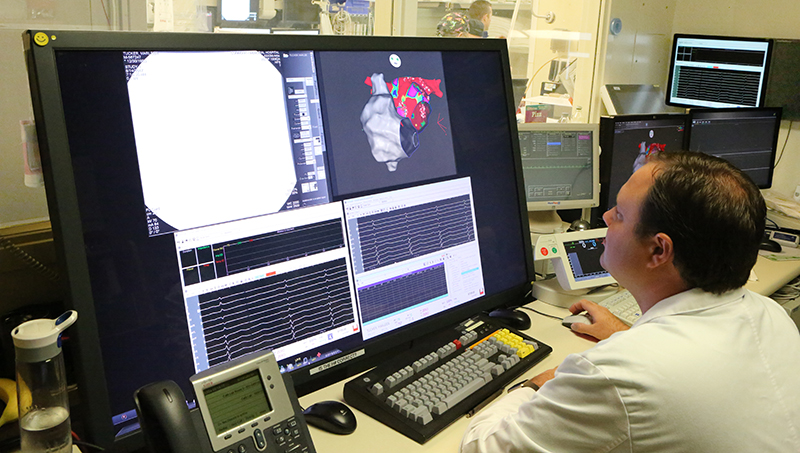
Complex Ablations For A-FIB, A-FLUTTER, VT, SVT, PVC
Pacemaker Implantation
A pacemaker insertion is the implantation of a small electronic device that is usually placed in the chest (just below the collarbone) to help regulate slow electrical problems of the heart. A pacemaker may be recommended to ensure that the heartbeat does not slow to a dangerously low rate.
Dr. Jonathan Dukes and Dr. Shaun Patel perform pacemaker implantation.
Defibrillator Implantation
An Implantable Cardioverter-Defibrillator (ICD) is a cardiac device that is intended for high risk patients to reduce their risk of dying if the lower chambers of the heart (ventricles) go into a dangerous rhythm and stop beating effectively (cardiac arrest).
Dr. Jonathan Dukes perform defibrillator implantation.
Watchman Procedure
The Watchman Procedure is among the newest procedures available to prevent
A-fib related stroke.
Dr. Jonathan Dukes and Dr Fatemi perform the Watchman Procedure.
Pacemaker And Defibrillator
Battery Replacement
A pacemaker battery usually lasts 7 to 8 years. When the battery runs down, a new pacemaker will be implanted. The surgery to replace the old pacemaker with a new one usually requires a local anesthetic. In most cases, your original pacemaker leads will not need to be replaced.
Implantable Monitoring Device
Reveal LINQ, Insertable Cardiac Monitor, is the world’s smallest implantable cardiac monitoring device. The procedure to implant one just takes a few minutes to perform as an outpatient. It records the heart rhythm continuously to capsure recurrent unexplained episodes of palpitations.
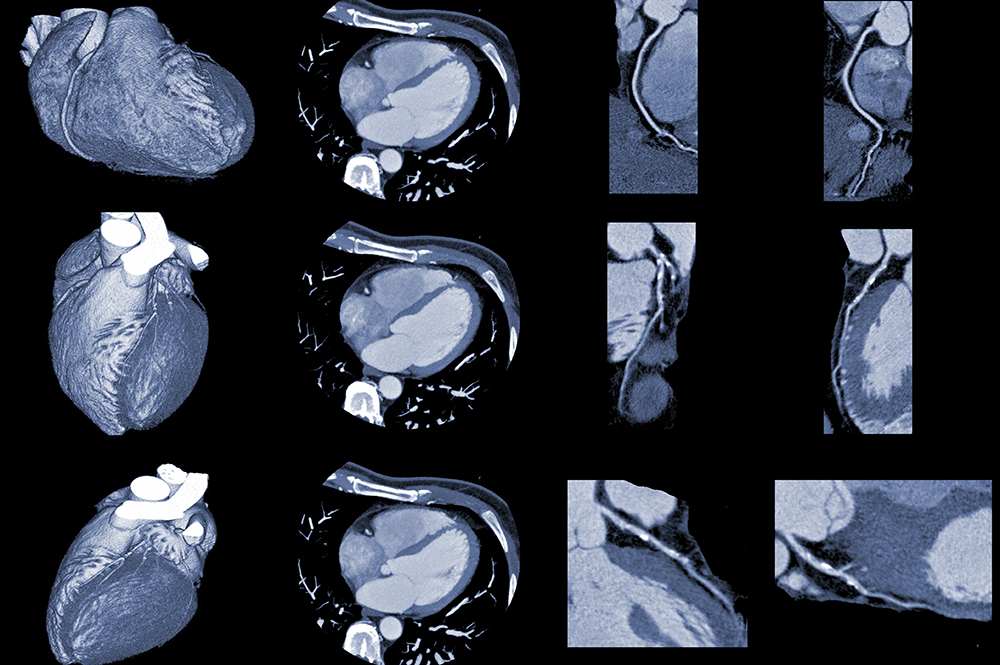
Cardiovascular Computed Tomography (Cardiac CT)
Cardiovascular Computed Tomography (Cardiac CT) – Also known as computed tomography; computed axial tomography scan (CAT scan). A cardiac CT scan is a painless imaging test that uses x rays to take many detailed pictures of your heart and its blood vessels. An electron beam CT scanner also can show calcium in coronary arteries.
Dr. Alon Steinberg is certified to interpret Cardiac CT scans.
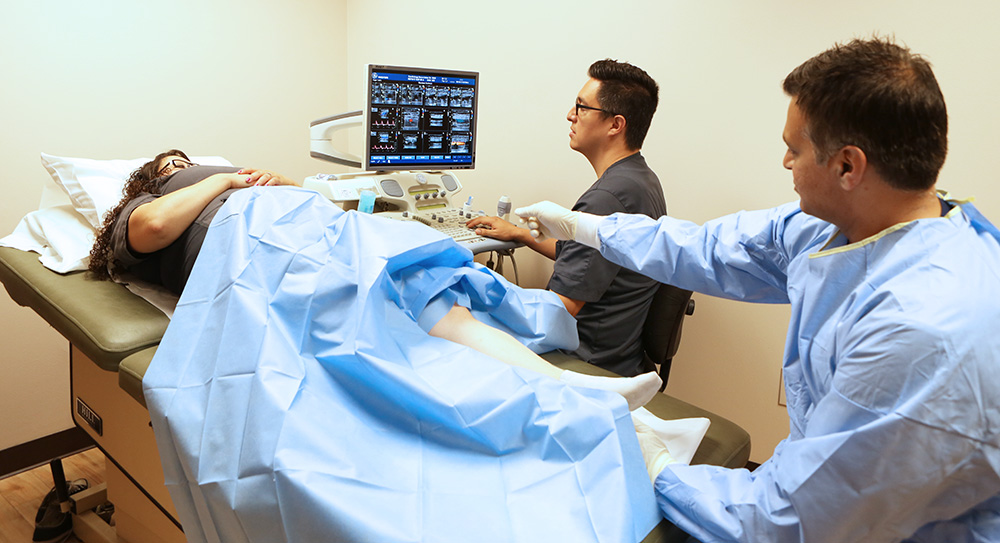
Varicose Veins Treatment
Endovenous Ablation is an image-guided, minimally invasive treatment for varicose veins. It uses radiofrequency or laser energy to cauterize (burn) and close the varicose veins. The results are remarkable. Patients who suffer with painful, disfiguring varicose veins now have the opportunity for a simple procedure with minimal pain.
Our vein lab founded in 2009, is located in Oxnard, CA. We treat patients who meet medically based requirements. Vein ablations are covered by most insurances.
Dr. Shaun Patel and Dr. Robert Sogomonian are board-certified in endovascular procedures.
